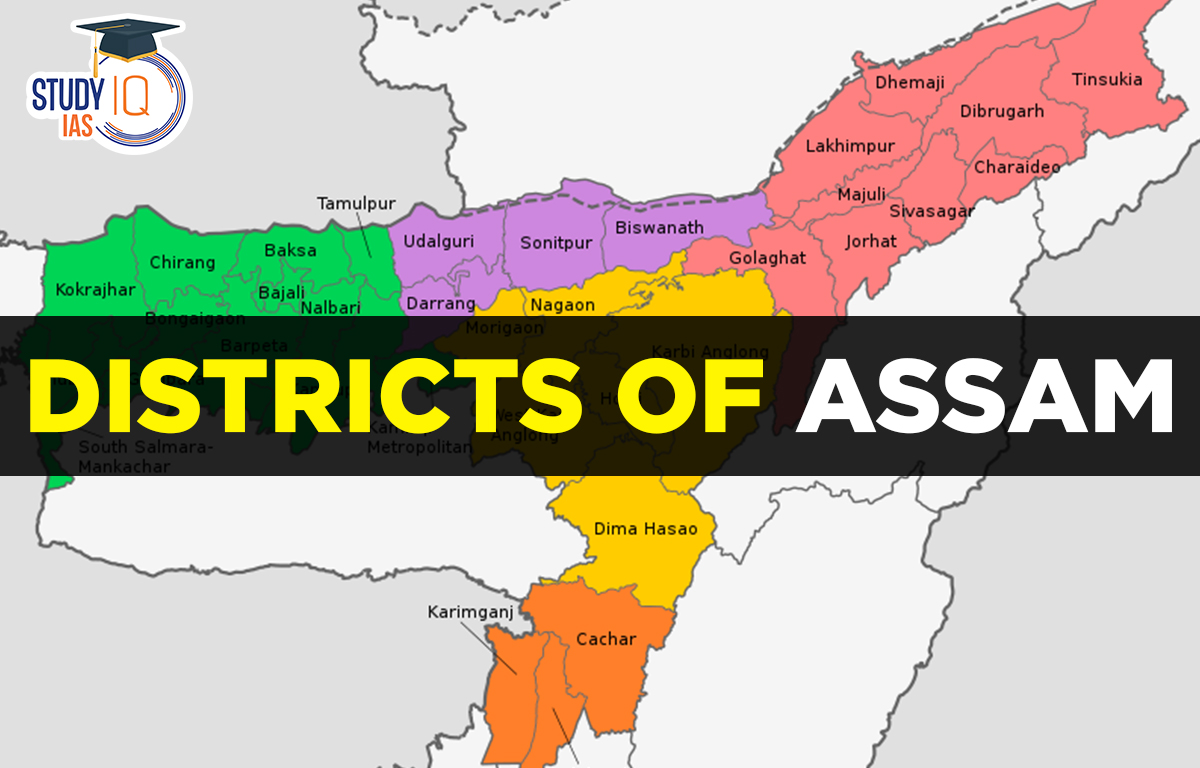Table of Contents
Districts of Assam
Assam is divided into 31 districts, each with its unique culture, heritage, economy, and tourist attractions. Most recently in December 2022 total number of districts became 31 from 33 due to the merger of Biswanath district with Sonitpur district and Hojai district with Nagaon district. The districts are spread across the state and vary in terms of geographical features, including hills, plains, and valleys. The majority of the population is engaged in agriculture and related industries, while other key sectors include tea production, tourism, and handloom weaving.
The state is home to several wildlife sanctuaries and national parks, making it a popular destination for nature lovers. Each district has its distinct cuisine, traditional attire, and festivals that reflect the diverse and vibrant cultural heritage of Assam.
Read More: District of Uttar Pradesh
Map of Districts of Assam
The map of the Districts of Assam shows the geographical locations and boundaries of all the districts in the state. It provides a visual representation of the distribution of various districts across the state. The map helps in identifying the neighbouring districts and the proximity to neighbouring states.

Read More: Districts of Andhra Pradesh
List of Districts of Assam
| S. No | District | Importance |
| 1 | Baksa | Baksa is a relatively new district that was created in 2004. Baksa is also home to a number of indigenous communities, including the Bodo people. |
| The district is known for its beautiful natural landscapes, including the Manas National Park and the Barnadi Wildlife Sanctuary. | ||
| 2 | Barpeta | Barpeta is known for its rich cultural heritage, particularly in the field of music and literature. |
| The district is home to several important religious sites, including the Barpeta Satra, which is one of the most important centers of the Vaishnavite faith in Assam. | ||
| Barpeta is also a major producer of silk, and is known for its high-quality silk products. | ||
| 3 | Bongaigaon | Bongaigaon is an important commercial and industrial hub in Assam. |
| The district is known for its vast reserves of coal, which are mined in the nearby Margherita region. | ||
| Bongaigaon is also home to several important wildlife sanctuaries, including the Manas National Park and the Pobitora Wildlife Sanctuary. | ||
| 4 | Cachar | Cachar is known for its diverse cultural heritage, which includes a mix of Hindu, Muslim, and Buddhist traditions. The district is home to several important historical sites, including the ancient Khaspur Kingdom. |
| Cachar is also known for its high-quality tea, which is grown in the nearby Hailakandi and Karimganj districts. | ||
| 5 | Charaideo | Charaideo is known for its rich history and cultural heritage, and is home to several important historical sites, including the ancient capital of the Ahom Kingdom. |
| Charaideo’s burial grounds exhibit impressive architecture and craftsmanship, attracting tourists to the area. | ||
| The district is also known for its natural beauty, including the beautiful Dehing Patkai Wildlife Sanctuary. | ||
| 6 | Chirang | Chirang is a relatively new district that was created in 2004, is also home to a number of indigenous communities, including the Bodo and Rabha people. |
| The district is known for its beautiful natural landscapes, including the Buxa Tiger Reserve and the Manas National Park. | ||
| 7 | Darrang | Darrang is known for its beautiful natural landscapes, including the Orang National Park and the Bhairabkunda waterfall. |
| Located on the northern banks of the Brahmaputra River, the district is situated in the central region of Assam. | ||
| Barnodi, a wildlife sanctuary, is also present in Darrang district. | ||
| 8 | Dhemaji | Dhemaji is known for its beautiful natural landscapes, including the Subansiri River and the Gerukamukh Dam. |
| The Bardoibum-Beelmukh Wildlife Sanctuary is located in Dhemaji district. | ||
| Dhemaji is one of the most backward districts of Assam with economy being mainly agrciultural. | ||
| 9 | Dhubri | Dhubri is an important border district that shares its border with Bangladesh & is known as the “Land of Rivers” due to its location surrounded by three rivers. |
| The district was once an essential commercial center, and its river port was particularly busy for the trade of jute. | ||
| 10 | Dibrugarh | Dibrugarh, an industrial city in Upper Assam, is famous for having the world’s largest tea garden area, including a tea garden within the city. |
| The major industries located in Dibrugarh, Assam are tea processing, oil and natural gas, and plywood production. | ||
| Dibrugarh played a significant role in the history of Indian Railways as the first railway services in the entire Northeast region of India began here. | ||
| 11 | Dima Hasao | Dima Hasao is known for its diverse cultural heritage, which includes a mix of Hindu, Christian, and indigenous traditions. |
| The Dima Hasao district, granted Sixth Schedule status by the Constitution of India, is an autonomous district. | ||
| Dima Hasao is also known for its beautiful natural landscapes, including the Jatinga village known for bird suicides and the Haflong Hill Station. | ||
| 12 | Goalpara | Located in western Assam, Goalpara district is bordered by the Brahmaputra River to the north and Meghalaya to the south. |
| Sri Surya Pahar in Goalpara district is a rare blend of historical and cultural significance, featuring archaeological remains and exquisite rock-cut sculptures of Hindu, Buddhist, and Jain deities. | ||
| Goalpara is also a major producer of rice, and is known for its high-quality aromatic rice varieties. | ||
| 13 | Golaghat | Golaghat is known for its beautiful natural landscapes, including the Kaziranga National Park and the Nambor – Doigrung Wildlife Sanctuary. |
| Golaghat District is renowned for its advanced quality of Muga silk and Agaru oil. | ||
| The district offers an enriching tourism experience, with a range of pleasurable activities for visitors. | ||
| 14 | Hailakandi | Due to its lush greenery, pleasant climate, and hilly terrain, Hailakandi is renowned as a hill station in Assam. |
| The district is known for its production of quality tea, with several tea gardens located in the region. | ||
| Hailakandi also has a significant Muslim population, with the town of Katlicherra being known for its historic and cultural significance for the Muslim community in Assam. | ||
| 15 | Jorhat | Majuli, the world’s largest river island, is situated in Jorhat district of Assam. |
| Jorhat is a significant center of the tea industry in Assam. | ||
| Jorhat is a major center for arts and culture in Assam, and is home to several important cultural institutions, including the Jorhat Cultural Association and the Assam State Museum. | ||
| 16 | Kamrup Metropolitan | Kamrup Metropolitan is the most populous district in Assam and is home to the city of Guwahati, which is the largest city in the state. |
| The district is a major center for trade and commerce in Assam and is home to several important markets and business districts. | ||
| Kamrup Metropolitan is also home to several important historical and cultural sites, including the Kamakhya Temple, the Assam State Zoo, and the Regional Science Center | ||
| 17 | Kamrup | Kamrup is one of the largest and most diverse districts in Assam, and is home to several different ethnic groups, including the Bodo, Rabha, and Tiwa communities. |
| The district is home to Deepor Beel sanctuary known for its rich flora and fauna. | ||
| The district is famous for producing silk and cotton fabrics for home use, as well as brass cups and plates. | ||
| 18 | Karbi Anglong | Karbi Anglong district is located in the central part of Assam. |
| The economy of Karbi Anglong district is primarily based on agriculture, with rice being the main crop cultivated in the region. | ||
| The district is also known for its handicrafts, including weaving of traditional clothes, bamboo crafts, and pottery. | ||
| 19 | Karimganj | Karimganj district is in southern Assam, bordered by Bangladesh to the south and west. The economy of Karimganj district is primarily based on agriculture, with paddy being the main crop. Other crops such as jute, mustard, and vegetables are also grown. |
| The district also has a growing tourism industry due to its natural beauty and historical sites such as the Maibong Hill and the Khashpur Palace. | ||
| 20 | Kokrajhar | It is situated in the western part of Assam and shares its borders with Bhutan and West Bengal. Chakrashila Wildlife Park in Kokrajhar, Assam is home to the rare Golden Langurs. |
| Kokrajhar is also a major center for arts and culture in Assam, and is home to several important cultural institutions, including the Kokrajhar Music and Dance Academy. | ||
| 21 | Lakhimpur | Lakhimpur district is located in the northern part of the state of Assam, India. |
| The economy of Lakhimpur district is primarily based on agriculture, with tea, rice, and mustard being the major crops grown in the region. | ||
| The district is also known for its wildlife sanctuaries, including the Kaziranga National Park, which is home to the endangered one-horned rhinoceros. | ||
| 22 | Majuli | It is home to world’s largest river island, located in the Brahmaputra river in Assam. Majuli’s main industry is agriculture, with a rich and diverse tradition of growing as many as 100 varieties of rice without pesticides. |
| The distirct is also known for its ancient cultural and religious heritage, and is home to several Vaishnavite monasteries called “satras” that promote traditional art, music, and dance forms. | ||
| 23 | Morigaon | Morigaon district is located in central Assam and is known for its natural beauty and biodiversity. |
| The district has a significant population of tribal communities, including the Karbi and Dimasa tribes. | ||
| 24 | Nagaon | Nagaon is famous as the birthplace of famous Vaishnav saint Shankardev. |
| Rice is the main crop and staple food in Nagaon, while fisheries are another important contributor to the local economy. It also holds a crucial position in the extraction and trading of agarwood oil. | ||
| Some brick manufacturing industries have been established in villages in the district, providing employment opportunities for illiterate workers. | ||
| 25 | Nalbari | Nalbari is a district in the western part of the state of Assam in India. |
| Nalbari has several tourist attractions, including the Hari Mandir, Nalbari Satra, and the Pari Hareswar Devalaya. | ||
| Nalbari is known for its Sanskrit education and institutions such as Kamrup Sanskrit Sanjeevani Sabha, also called Nabadip. | ||
| 26 | Sivasagar | Sivasagar is a district located in the eastern part of the state of Assam, India. It is known for its rich history and culture, and was once the capital of the Ahom kingdom. |
| The district is home to the Sivasagar Tank, which is the second-largest man-made lake in Asia and a popular tourist destination. | ||
| Sivasagar is also known for its tea gardens, oil fields, and traditional handicrafts such as pottery and weaving. | ||
| 27 | Sonitpur | Sonitpur is a district located in the northern part of the state of Assam, India. |
| Important tourist destinations of Sonitpur is the Nameri National Park. | ||
| The district is home to the Tezpur University, which is a renowned educational institution in the region. | ||
| 28 | South Salmara-Mankachar | It was formed in 2020 and is one of the newest districts in the state. |
| The district is situated on the international border with Bangladesh and is predominantly rural, with agriculture and fishing being the main sources of income for the local population. | ||
| 29 | Tinsukia | Tinsukia district is located in the eastern part of Assam, sharing its borders with Arunachal Pradesh in the north. |
| The Tilinga Mandir, also known as the Bell Temple, is a renowned Shiva temple located in Bordubi, which is situated 17 km away from the Tinsukia District | ||
| It is also famous for being birthplace of Bharat Ratna Bhupen Hazarika. | ||
| 30 | Udalguri | Udalguri district is located in the Bodoland Territorial Region of Assam, India. It was formed in 2004 when it was carved out of Darrang district. |
| The economy of Udalguri is primarily based on agriculture, with tea being the major crop grown in the region. Other important crops include jute, paddy, and mustard. | ||
| The district is also known for its vibrant cultural festivals, such as the Bathou Puja, a traditional Bodo festival celebrated to worship the God of the household and the community. | ||
| 31 | West Karbi Anglong | West Karbi Anglong is a district located in the Karbi Anglong region of Assam, India. The district was established in 2016. |
| The economy of West Karbi Anglong is primarily based on agriculture and horticulture. The district is known for its production of oranges, pineapples, and other fruits. |
Read More: Districts of Punjab


 UPPSC Recruitment 2026 Notification Out ...
UPPSC Recruitment 2026 Notification Out ...
 StudyIQ IAS Mega Walk-In Drive 2025: Hir...
StudyIQ IAS Mega Walk-In Drive 2025: Hir...
 UPSC EPFO Result 2025 Out: EO/AO and APF...
UPSC EPFO Result 2025 Out: EO/AO and APF...

























